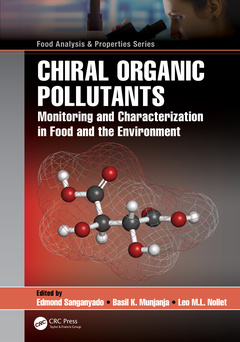Chiral Organic Pollutants Monitoring and Characterization in Food and the Environment Food Analysis & Properties Series
Coordonnateurs : Sanganyado Edmond, Munjanja Basil K., Nollet Leo M.L.

Chiral Organic Pollutants introduces readers to the growing challenges of chirality in synthetic chemicals. In this volume, contributors brilliantly summarize the characteristics of chiral pollutants to provide tools and techniques for effectively assessing their environmental and human health risks. Chapters cover recent research on the physicochemical properties, sources, exposure pathways, environmental fate, toxicity, and enantioselective analysis of chiral organic pollutants. Chiral Organic Pollutants also provides comprehensive discussions on the current trends in the synthesis and legislation of chiral chemicals.
Key Features:
- Includes sampling and analytical methods for the enantioselective analysis of a wide array of chiral organic pollutants in food and the environment
- Summarizes recent research on the sources, fate, transport, and toxicity of chiral organic pollutants in the environment
- Critically examines the sources and pathways of chiral organic pollutants such as pesticides, pharmaceuticals, and flame retardants in food
- Includes a comprehensive discussion on current trends in the enantioselective synthesis and chiral switching of pesticides and pharmaceuticals
- Provides analysis of current national and international regulations of chiral synthetic chemicals
The use of chiral synthetic chemicals such as pesticides, pharmaceuticals, personal care products, and halogenated flame retardants has significantly grown in the past 60 years. Hence, understanding the human and environmental health effects of chiral organic pollutants is crucial in the industry, academia, and policymaking. Chiral Organic Pollutants is an excellent textbook and reference for students, scientists, engineers, and policymakers interested in food quality, environmental pollution, chemical analysis, organic synthesis, and toxicology.
Also available in the Food Analysis and Properties Series:
Analysis of Nanoplastics and Microplastics in Food, edited by Leo. M.L. Nollet and Khwaja Salahuddin Siddiqi (ISBN: 9781138600188)
Proteomics for Food Authentication, edited by Leo M.L. Nollet, and Semih Ötle? (ISBN: 9780367205058)
Mass Spectrometry Imaging in Food Analysis, edited by Leo M.L. Nollet (ISBN: 9781138370692)
For a complete list of books in this series, please visit our website at:
www.crcpress.com/Food-Analysis--Properties/book-series/CRCFOODANPRO
1. Overview on Chiral Pollutants in the Environment and Food. Section I: Analysis, Fate, and Toxicity of Chiral Pollutants in the Environment. 2. Chiral Inverstion of Organic Pollutants. 3. Chiral Pesticides. 4. Analysis, Fate, and Toxicity of Chiral Pharmaceuticals in the Environment. 5. Chiral Personal Care Products: Occurrence, Fate, and Toxicity. 6. Chiral Halogenated Organic Contaminants of Emerging Concern. 7. Persistent Organic Pollutants. Section II: Analysis, Fate, and Toxicity of Chiral Pollutants in Food. 8. Current Trends in Enantioselective Food Analysis. 9. Occurrence of Chiral Pesticides in Food and Their Effects on Food Processing and the Health of Humans. 10. Chiral Pharmaceuticals: Source, Human Risk, and Future Studies. 11. Food Authenticity and Adulteration. Section III: Regulation and Remediation of Chiral Pollutants. 12. Regulatory Perspectives and Challenges in Risk Assessment of Chiral Pollutants. Section IV: Synthesis and Chiral Switching of Chiral Chemicals. 13. Chiral Pesticides: Synthesis, Chiral Switching, and Absolute Configuration. 14. Chiral Pharmaceuticals: Synthesis and Chiral Switching.
Edmond Sanganyado, is an associate professor in the College of Science at Shantou University, China. He obtained his B.Sc. (Hons) in Applied Chemistry from the National University of Science and Technology, Zimbabwe, and his Ph.D. in Environmental Toxicology from the University of California Riverside under the direction of Dr. Jay Gan. Dr. Sanganyado worked as an analytical chemist at Kutsaga Research Station, where he gained expertise in chromatographic analysis. He was a postdoctoral research fellow at Shantou University before he was appointed an associate professor. Dr. Sanganyado has written over 30 peer-reviewed papers in journals such as Chemical Engineering Journal, Water Research, Environment International, and Environmental Pollution. His research focuses on the application of chromatographic and spectroscopic techniques to understand the behavior of chemical pollutants in aquatic environments. He contributed to our understanding of the implications of stereochemistry on the analysis, fate, and toxicity of chiral pollutants. In recognition of his contribution to sustainability, the International Union of Pure and Applied Chemistry awarded him the Periodic Table of the Younger Chemists. Dr. Sanganyado is the recipient of numerous awards, including the Fulbright Fellowship (2011), Zhujiang Postdoctoral Fellowship (2017), Shantou University Excellent Postdoctoral Fellowship (2018), IUPAC Periodic Table of the Younger Chemists Award (2018), and Shantou University Outstanding Young Talent (2019).
Basil K Munjanja received his BSc (Hons) in Applied Chemistry (2013) from the National University of Science and Technology, Zimbabwe. From 2013 to-date, he has authored thirteen book chapters on various topics such as Biopesticides, spectroscopy, and mass spectrometry, for CRC Press, Taylor and Francis in books namely Handbook of Food Analysis (3rd edition), Biopesticides Handbook, FIA book, and Chromatographic Analysis of
Date de parution : 12-2020
17.8x25.4 cm
Thèmes de Chiral Organic Pollutants :
Mots-clés :
Chiral Pesticides; CSPs; Environmental Pollution; PFOA; organic pollutants; SFC; chiral analysis; Chiral Pharmaceuticals; chiral separation; Enantiomeric Composition; chiral inversion; enantiomerization; Organic UV Filter; Food components; Chiral Selector; Chiral organic pollutants; Enantioselective Analysis; Human health risks; Chiral Switching; Chiral synthetic chemicals; Chiral Inversion; Enantioselective Degradation; Chiral Compounds; Electronic Circular Dichroism Spectra; Synthetic Musks; Enantioselective Behavior; Enantiomeric Distribution; Brominated Flame Retardants; Polycyclic Musks; Enantiomeric Enrichment; Halogenated Flame Retardants; Multidimensional Gas Chromatography; Chiral Drugs; Polyfluoroalkyl Substances; PFOS


